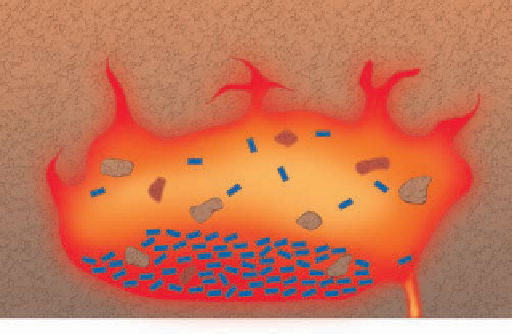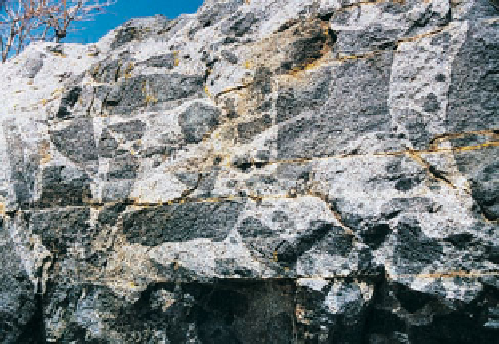Geology Reference
In-Depth Information
Magma chamber
Assimilated pieces
of country rock
Country rock
Crystal
settling
Inclusion
Early-formed ferromagnesian silicates are denser
than the magma and settle and accumulate in the
magma chamber. Fragments of rock dislodged by
upward-moving magma may melt and be incorporated
into the magma, or they may remain as inclusions.
a
Dark inclusions in granitic rock.
b
◗
Figure 4.7
Crystal Settling and Assimilation
mafic magma. In some thick, sheetlike plutons called
sills
,
the fi rst-formed ferromagnesian silicates are indeed concen-
trated in their lower parts, thus making their upper parts less
mafi c. But even in these plutons, crystal settling has yielded
very little felsic magma.
To yield a particular volume of granite (a felsic igneous
rock), approximately 10 times as much mafi c magma would
have to be present initially for crystal settling to yield the vol-
ume of granite in question. If this were so, then mafi c intrusive
igneous rocks would be much more common than felsic ones.
However, just the opposite is the case, so it appears that mecha-
nisms other than crystal settling must account for the large
volume of felsic magma. Partial melting of mafi c oceanic crust
and silica-rich sediments of continental margins during sub-
duction yields magma richer in silica than the source rock. Fur-
thermore, magma rising through the continental crust absorbs
some felsic materials and becomes more enriched in silica.
The composition of magma also changes by
assimilation
,
a process by which magma reacts with preexisting rock, called
country rock
, with which it comes in contact (Figure 4.7). The
walls of a volcanic conduit or magma chamber are, of course,
heated by the adjacent magma, which may reach tempera-
tures of 1300°C. Some of these rocks partially or completely
melt, provided that their melting temperature is lower than
that of the magma. Because the assimilated rocks seldom
have the same composition as the magma, the composition
of the magma changes.
The fact that assimilation occurs is indicated by
inclusions
,
incompletely melted pieces of rock that are fairly common
in igneous rocks. Many inclusions were simply wedged loose
from the country rock as magma forced its way into preex-
isting fractures (Figure 4.7). No one doubts that assimilation
takes place, but its effect on the bulk composition of magma
must be slight. The reason is that the heat for melting comes
from the magma itself, and this has the effect of cooling the
magma. Only a limited amount of rock can be assimilated by
magma, and that amount is insuffi cient to bring about a major
compositional change.
Neither crystal settling nor assimilation can produce a
significant amount of felsic magma from a mafic one. But
both processes, if operating concurrently, can bring about
greater changes than either process acting alone. Some ge-
ologists think that this is one way that intermediate magma
forms where oceanic lithosphere is subducted beneath
continental lithosphere.
A single volcano can erupt lavas of different composition,
indicating that magmas of differing composition are pres-
ent. It seems likely that some of these magmas would come
into contact and mix with one another. If this is the case, we
would expect that the composition of the magma resulting
from
magma mixing
would be a modifi ed version of the par-
ent magmas. Suppose rising mafi c magma mixes with felsic
magma of about the same volume (
Figure 4.8). The resulting
“new” magma would have a more intermediate composition.
◗
CHARACTERISTICS AND
CLASSIFICATION
We have already defined
plutonic
or
intrusive igneous rocks
and
volcanic
or
extrusive igneous rocks.
Here we will have
considerably more to say about the texture, composition,
and classification of these rocks, which constitute one of
the three major rock families depicted in the rock cycle
(see Figure 1.14).











Search WWH ::

Custom Search